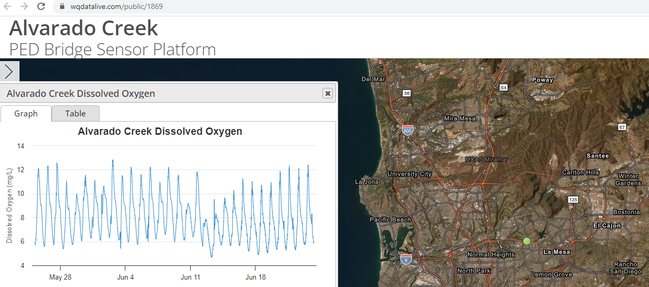Urban Rivers Water Quality Research

Image at left shows how contaminants are mobilized from belowground sewer exfiltration by "interflow" (lateral groundwater flow in the vadose zone) and from aboveground sources by stormwater runoff.
Image at right shows the increase in HF183 bacteria concentration and caffeine/sucralose (C/S) ratio that accompanies the rise in E. coli concentrations in the San Diego River during storm events. Our research shows high HF183 and high C/S are markers of raw sewage and not open defecation.
Copyright 2020, N. Mladenov and F. Pinongcos
Image at right shows the increase in HF183 bacteria concentration and caffeine/sucralose (C/S) ratio that accompanies the rise in E. coli concentrations in the San Diego River during storm events. Our research shows high HF183 and high C/S are markers of raw sewage and not open defecation.
Copyright 2020, N. Mladenov and F. Pinongcos
San Diego River Contamination Study
WIRLab's collaborative research with the Safe Water Lab, Disturbance Hydrology Lab, and Public Health at SDSU, reveals that leaky sewers have a major influence on water quality in the San Diego River during storm events and that waste associated with homeless encampments is less of a contributor, but not negligible.
For more information, please see our San Diego River Contamination Study site, which describes key background, the research team, and key results.
Products from the study:
Executive Summary
Final Report with detailed results
Video summarizing our findings
Article on untreated wastewater influence on San Diego River water quality during storm events
Article on water quality downstream of homeless encampments
Article on persistence of fecal markers in riverbank soils
CBS 8 news story on our study
San Diego Union Tribune news story on our study
WIRLab's collaborative research with the Safe Water Lab, Disturbance Hydrology Lab, and Public Health at SDSU, reveals that leaky sewers have a major influence on water quality in the San Diego River during storm events and that waste associated with homeless encampments is less of a contributor, but not negligible.
For more information, please see our San Diego River Contamination Study site, which describes key background, the research team, and key results.
Products from the study:
Executive Summary
Final Report with detailed results
Video summarizing our findings
Article on untreated wastewater influence on San Diego River water quality during storm events
Article on water quality downstream of homeless encampments
Article on persistence of fecal markers in riverbank soils
CBS 8 news story on our study
San Diego Union Tribune news story on our study
Real-time water quality monitoring
Alvarado Creek
This project (PI Zink and Co-PIs Mladenov, and Kinoshita) uses in-situ sensors to track pollution in this tributary of the San Diego River during dry and wet weather.
Real-time water quality now available. Click the image below:
Alvarado Creek
This project (PI Zink and Co-PIs Mladenov, and Kinoshita) uses in-situ sensors to track pollution in this tributary of the San Diego River during dry and wet weather.
Real-time water quality now available. Click the image below:
San Diego River
This project (PI Biggs from SDSU Geography, and Co-PI Mladenov from SDSU Environmental Engineering) seeks to track anthropogenic contamination in the San Diego River at Mission Trails during storm events, using in-situ fluorescence-based sensors that provide real-time data via telemetry.
Check out the Biggs Lab website for more information.
This project (PI Biggs from SDSU Geography, and Co-PI Mladenov from SDSU Environmental Engineering) seeks to track anthropogenic contamination in the San Diego River at Mission Trails during storm events, using in-situ fluorescence-based sensors that provide real-time data via telemetry.
Check out the Biggs Lab website for more information.
Tijuana River and Estuary
The research teams of Biggs (SDSU Geography) and Mladenov (SDSU Environmental Engineering) have installed and maintain two sensor platforms, one in the Tijuana River at the US-Mexico border and one in the Tijuana River National Estuarine Research Reserve, to track cross-border flows and provide a real-time warning of sewage pollution using in-situ fluorescence-based sensors and telemetry.
Check out the Biggs Lab website for more information.
The research teams of Biggs (SDSU Geography) and Mladenov (SDSU Environmental Engineering) have installed and maintain two sensor platforms, one in the Tijuana River at the US-Mexico border and one in the Tijuana River National Estuarine Research Reserve, to track cross-border flows and provide a real-time warning of sewage pollution using in-situ fluorescence-based sensors and telemetry.
Check out the Biggs Lab website for more information.
Alvarado Creek Water Quality Study
In collaboration with the Disturbance Hydrology Lab and the SDSU Soil Ecology and Restoration Group, the chemical profiles of dry weather flow in Alvarado Creek, a tributary of the San Diego River, support saline groundwater as a main source of water flow during dry weather, creating brackish conditions. During wet weather, chemical and optical properties indicate that shallow vadose zone flow may mobilize contaminants from the subsurface. Dry weather flows were found to contribute as much organic carbon to downstream and coastal waters as wet weather/storm events. Dry weather flows also produced more reactive nitrogen, whereas during wet weather, Alvarado Creek was more of a passive pipe transporting nitrogen to receiving waters.
Read our study on Groundwater-surface water interactions in this urban, Mediterranean stream.
In collaboration with the Disturbance Hydrology Lab and the SDSU Soil Ecology and Restoration Group, the chemical profiles of dry weather flow in Alvarado Creek, a tributary of the San Diego River, support saline groundwater as a main source of water flow during dry weather, creating brackish conditions. During wet weather, chemical and optical properties indicate that shallow vadose zone flow may mobilize contaminants from the subsurface. Dry weather flows were found to contribute as much organic carbon to downstream and coastal waters as wet weather/storm events. Dry weather flows also produced more reactive nitrogen, whereas during wet weather, Alvarado Creek was more of a passive pipe transporting nitrogen to receiving waters.
Read our study on Groundwater-surface water interactions in this urban, Mediterranean stream.


